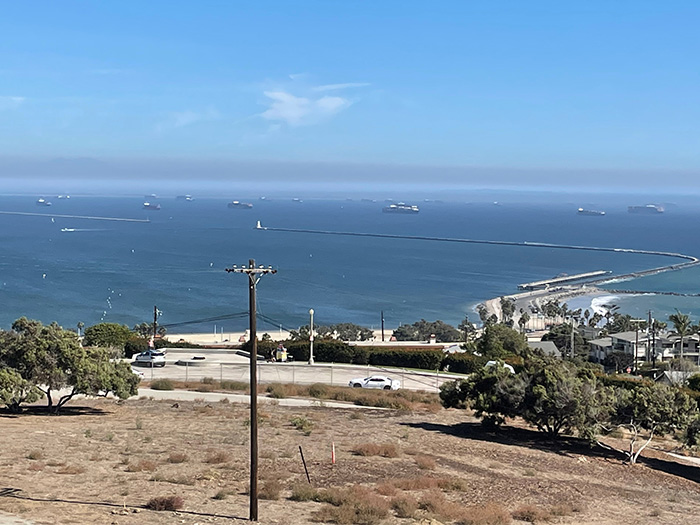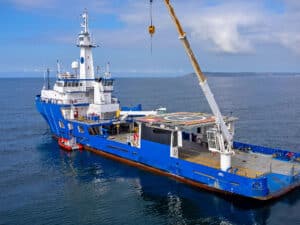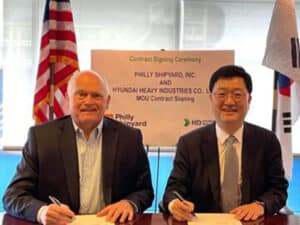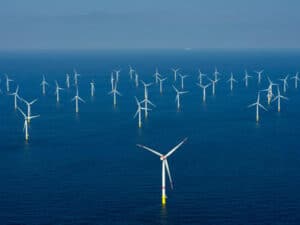
Newsom issues executive order on port congestion
Written by Nick Blenkey
Image tweeted by Marine Exchange of Southern California shows ships on hold in San Pedro Bay.
As the number of ships at anchor or in holding areas at San Pedro Bay continues at record highs, California Gov. Gavin Newsom this week issued an executive order aiming to tackle the supply chain crisis.
The order was issued as the Marine Exchange of Southern California reported that, as of October 20, there were 169 total ships in port at Los Angeles and Long Beach, including 109 at anchor or holding areas and 60 at berths. Of the 169, 108 are containerships, including 79 at anchor or in holding areas and 29 at berth. The 55 vessels in holding areas were 44 containerships, three tankers and eight bulk carriers
According to Newsom’s office, the executive order directs state agencies to identify additional ways to alleviate congestion at California ports. The executive order builds on earlier efforts this year by the Governor’s Office of Business and Economic Development (GO-Biz) to ease supply chain issues by engaging the diverse network of stakeholders along the supply chain to discuss key challenges and identify short-term and long-term solutions. Record demand for imported goods combined with capacity issues across the entire supply chain have slowed distribution at ports on the California coast.
“California’s ports are critical to our local, state and national economies and the state is taking action to support goods movement in the face of global disruptions,” said Newsom. “My administration will continue to work with federal, state, labor and industry partners on innovative solutions to tackle immediate challenges while also bringing our distribution processes into the 21st century.”
The executive order directs state agencies to continue coordinating with the Biden-Harris Administration Supply Chain Disruptions Task Force to address state, national and global supply chain challenges. The executive order also directs the Department of Finance to work with state agencies to develop longer-term solutions that support port operations and goods movement for consideration in the January 10 Governor’s Budget, which may include port and transportation infrastructure improvements, electrification of the goods movement system from port to delivery, and workforce development.
After a lot of “whereas” verbiage, the executive order specifically directs that:
- The Department of Transportation, in partnership with the California State Transportation Agency, within 30 days of this Order, shall, in collaboration with industry stakeholders, evaluate and identify priority freight routes to be considered for a temporary exemption to current gross vehicle weight limits.
- The Governor’s Office of Business and Economic Development shall identify non-state sites, including private, locally owned, and federally owned parcels, that could be available to address short-term storage needs to address the supply and distribution chain crisis.
- The Department of General Services shall complete its review of state owned property in proximity to impacted ports that may be made available to address short-term storage needs to address the supply and distribution chain crisis by no later than December 15, 2021. To meet this deadline, all agencies under my direct executive authority shall support this effort by timely responding to all inquiries made by the Department of General Services.
- The Department of General Services shall collaborate with other state agencies to expedite leasing for the purpose of storing cargo containers on state-owned parcels identified pursuant to the Department of General Services’ review.
- The California Labor and Workforce Development Agency shall use existing resources to identify potential high road training partnerships to increase education, career technical education, job training, and workforce development opportunities for port workers and other workers across the supply chain. In identifying such opportunities, the California Labor and Workforce Development Agency shall first consider whether such partnerships can be funded through existing sources, such as the federal Workforce Innovation and Opportunity Act.
- By December 31, 2021, the California Labor and Workforce Development Agency shall take all necessary actions to constitute and announce the membership of the industry panel required by AB 639 and codified at Government Code section 12893.1 (a). The Secretary of Labor shall convene the panel for its first meeting by March 1, 2022.
- The Department of Finance shall work with state agencies and departments to develop longer term proposals that support port operations and goods movement for consideration in the January 10 Governor’s Budget. Proposals may include port and transportation infrastructure improvements, electrification of the goods movement system from port to delivery, workforce development, and other actions to support goods movement.
- The Department of General Services, California Department of Food and Agriculture, the Governor’s Office of Business and Economic Development, California State Transportation Agency, Department of Transportation, and the California Labor and Workforce Development Agency shall use all existing legal and financial authority to expedite and prioritize these activities, including by giving them preference in the award of state funding, pursuant to my further direction. Agencies not under my direct executive authority are requested to do the same.
- The California State Transportation Agency, the California Department of Food and Agriculture, the Governor’s Office of Business and Economic Development, and the California Labor and Workforce Development Agency shall continue to execute actions in coordination with the Biden Harris Administration Supply Chain Disruptions Task Force.




